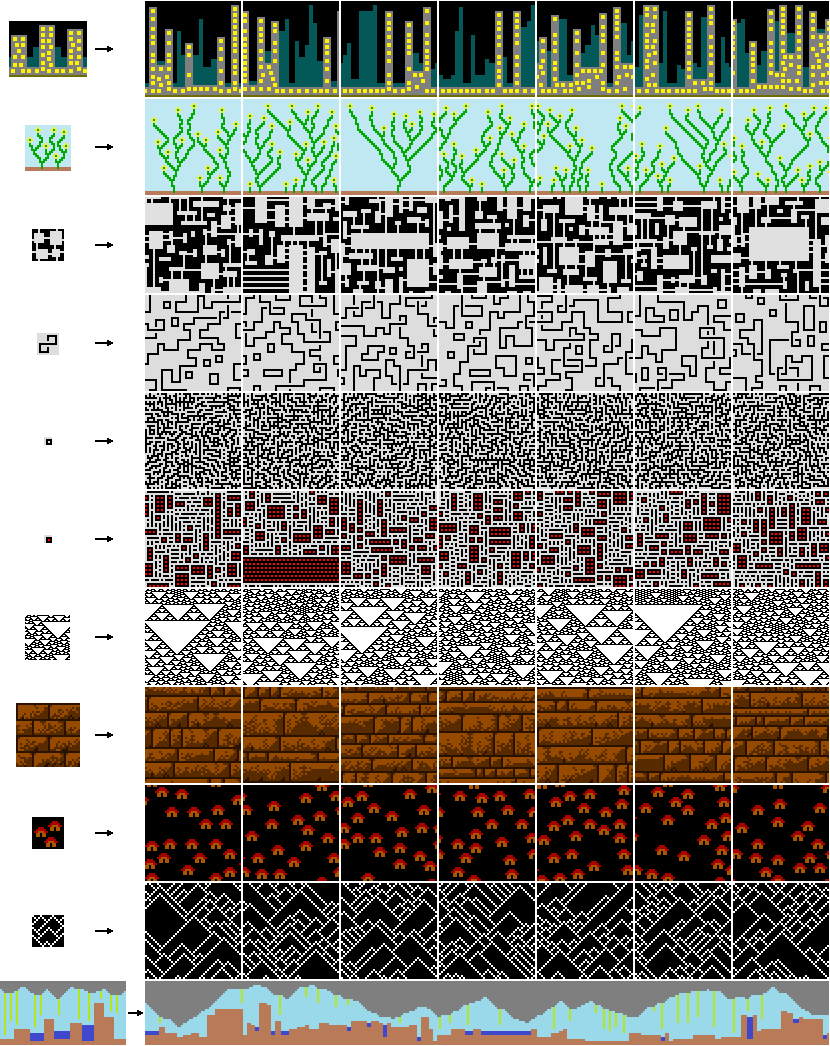
在程序生成和模式设计领域,基于约束的自动化算法能有效减少人工干预。WaveFunctionCollapse(WFC)通过模拟量子力学的波函数坍缩过程,实现从局部约束到全局结构的自洽推导。本文将从算法原理到工程实践,深度解析WaveFunctionCollapse的核心机制与使用方法,帮助开发者构建基于约束的生成系统。
一、核心架构与算法原理
-
约束满足模型
- 模式库构建:定义基础元素及其相邻约束关系
- 波函数表示:每个位置的可能状态集合(未坍缩前的叠加态)
- 坍缩过程:通过熵最小原则选择下一步坍缩的单元
-
算法执行流程
输入模式库 → 初始化波函数 → 循环坍缩: 1. 选择熵最低的单元 2. 随机选择该单元的有效状态 3. 传播约束消除冲突 直到完成或失败 -
约束传播机制
def propagate_constraint(cell, state): for neighbor in get_neighbors(cell): if neighbor not in collapsed: allowed = neighbor.possible_states # 根据当前单元状态过滤邻居可能状态 allowed &= get_compatible_states(cell, state) if not allowed: return False neighbor.possible_states = allowed return True
二、快速实现与基础配置
1. 环境初始化
# 安装依赖(以Python为例)
pip install numpy matplotlib
2. 模式库定义
# 定义瓷砖模式及约束关系
tiles = {
'grass': {'up': ['grass', 'tree'], 'down': ['grass']},
'tree': {'up': ['grass'], 'down': ['tree']},
}
3. 基础算法实现
class WaveFunctionCollapse:
def __init__(self, pattern, width, height):
self.grid = [[set(pattern.keys()) for _ in range(width)] for _ in range(height)]
self.pattern = pattern
self.width = width
self.height = height
def collapse(self):
while not self.is_complete() and not self.has_conflict():
cell = self.select_lowest_entropy_cell()
state = random.choice(list(self.grid[cell[0]][cell[1]]))
self.set_state(cell, state)
self.propagate(cell)
def set_state(self, cell, state):
self.grid[cell[0]][cell[1]] = {state}
self.collapsed.add(cell)
三、高级功能实现
1. 动态约束调整
# 基于用户输入添加约束
def add_custom_constraint(cell, forbidden_states):
if cell in self.collapsed:
return False
self.grid[cell[0]][cell[1]] -= forbidden_states
return True
2. 多层级生成
# 分阶段生成复杂结构
def hierarchical_collapse():
# 第一阶段生成基础地形
base_grid = WaveFunctionCollapse(base_patterns, 100, 100).collapse()
# 第二阶段在地形上叠加建筑
building_grid = WaveFunctionCollapse(building_patterns, 100, 100)
building_grid.set_constraints_from(base_grid)
return building_grid.collapse()
3. 熵启发式优化
def select_lowest_entropy_cell(self):
min_entropy = float('inf')
selected = None
for y in range(self.height):
for x in range(self.width):
if (x,y) not in self.collapsed:
current_entropy = len(self.grid[y][x])
if current_entropy < min_entropy:
min_entropy = current_entropy
selected = (x,y)
return selected
四、程序分析与调试
1. 约束冲突检测
def has_conflict(self):
for row in self.grid:
for cell in row:
if not cell:
return True
return False
2. 生成过程可视化
def visualize(self):
plt.imshow([[len(cell) for cell in row] for row in self.grid], cmap='viridis')
plt.colorbar(label='Remaining States')
plt.show()
3. 参数调优
# 调整坍缩策略
def greedy_collapse(self):
while not self.is_complete():
# 强制选择唯一候选状态
cell = self.find_unique_candidate()
if cell:
state = list(self.grid[cell[0]][cell[1]])[0]
self.set_state(cell, state)
self.propagate(cell)
else:
break
五、深度定制与扩展
1. 概率权重支持
# 添加状态选择权重
def weighted_choice(self, possible_states):
weights = [self.pattern[state]['weight'] for state in possible_states]
return random.choices(list(possible_states), weights)[0]
2. 三维空间扩展
class 3DWaveFunction:
def __init__(self, x, y, z, patterns):
self.grid = [[[
set(patterns.keys()) for _ in range(z)
] for _ in range(y)] for _ in range(x)]
3. 自定义传播规则
def custom_propagate(self, cell, state):
# 自定义约束传播逻辑
for direction in ['north', 'south', 'east', 'west']:
neighbor = get_neighbor(cell, direction)
if neighbor and neighbor not in self.collapsed:
# 应用方向特定约束
neighbor.possible_states &= get_allowed_states(state, direction)
六、性能优化与调试
1. 并行化处理
# 使用多线程坍缩
def parallel_collapse(self):
with concurrent.futures.ThreadPoolExecutor() as executor:
futures = []
for cell in self.get_candidate_cells():
futures.append(executor.submit(self.process_cell, cell))
concurrent.futures.wait(futures)
2. 内存管理
# 稀疏矩阵优化
class SparseGrid:
def __init__(self, width, height):
self.cells = {}
# 仅存储未坍缩的单元
3. 日志追踪
def debug_log(self):
with open('collapse.log', 'w') as f:
for y, row in enumerate(self.grid):
f.write(f"Row {y}: {[' '.join(map(str, cell)) for cell in row]}\n")
七、企业级应用场景
1. 游戏地图生成
# 生成包含地形和建筑的复合地图
def generate_game_map():
terrain = WaveFunctionCollapse(terrain_patterns, 256, 256).collapse()
buildings = WaveFunctionCollapse(building_patterns, 256, 256)
buildings.add_overlap_constraints(terrain)
return buildings.collapse()
2. 程序代码生成
# 生成符合约束的代码结构
def generate_code_ast(constraints):
ast_collapse = WaveFunctionCollapse(code_patterns, max_depth, max_nodes)
ast_collapse.set_constraints(constraints)
return ast_collapse.collapse()
3. 生物序列分析
# 推导符合约束的DNA序列
def sequence_inference(constraints):
seq_collapse = WaveFunctionCollapse(base_patterns, sequence_length)
seq_collapse.apply_biophysical_rules(constraints)
return seq_collapse.collapse()
八、算法局限与解决方案
1. 死锁检测
def is_deadlock(self):
for row in self.grid:
for cell in row:
if not cell and cell not in self.collapsed:
return True
return False
2. 随机重启策略
def stochastic_restart():
attempts = 0
while attempts < 100:
try:
grid = WaveFunctionCollapse(patterns, width, height).collapse()
return grid
except CollapseFailure:
attempts +=1
return None
3. 混合生成模式
def hybrid_collapse():
# 结合传统算法与WFC
partial_grid = traditional_method()
wfc = WaveFunctionCollapse(patterns, width, height)
wfc.set_initial(partial_grid)
return wfc.collapse()
总结
WaveFunctionCollapse通过约束传播和概率坍缩机制,为程序生成和模式设计提供了创新解决方案。其核心优势体现在:
- 自洽性保证:所有生成结果严格符合预定义约束
- 可解释性:通过熵值监控生成过程的确定性
- 多领域适用:从游戏开发到生物信息学的广泛适应性
开发者通过本文的实现方法与算法分析,可快速构建基于约束的自动化生成系统。在地图生成、代码优化、艺术设计等场景中,WFC的约束推导能力能显著提升复杂系统的构建效率,同时保持结果的逻辑一致性与视觉合理性。